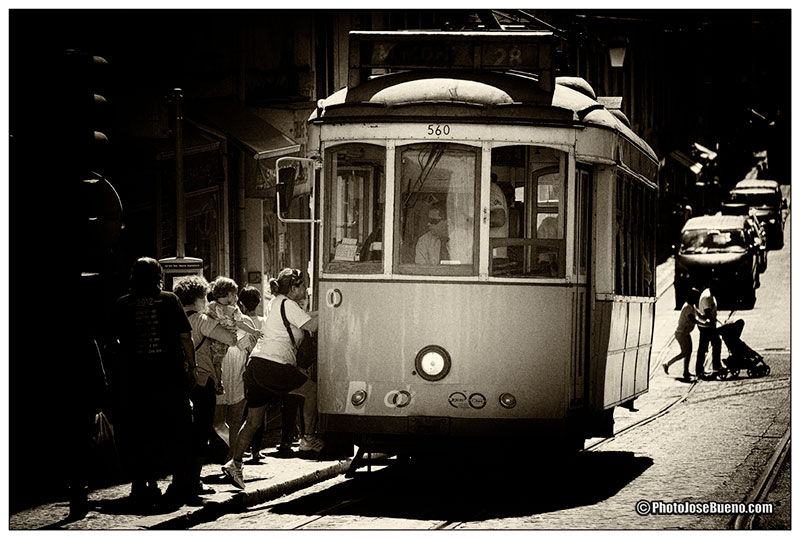
Nikon D700 – Nikkor 135mm. – 1/2000s – f:4.0 – ISO 200
Hace tiempo que llevaba pensando hacer una escapada de fin de semana en busca de fotografías distintas a lo que suelo hacer tirado en circuitos o por carreteras secundarias probando y fotografiando coches. No es que esto no me guste pero seguramente estarás de acuerdo que hasta el plato más exquisito cansa.
Mi idea era buscar un poco mis orígenes en el mundo de la fotografía con una cámara de enfoque manual, recordado así mi primera réflex de la marca Zenit que compré hace ya hace casi 40 años.
Descartando las cámaras de carrete que tengo de colección y que aunque funcionan a la perfección su sistema me resulta demasiado “romántico”. Como buen géminis no me terminaba por decidir si llevar una réflex o una telemétrica. Por un lado estoy mucho más acostumbrado al uso de las réflex pero por otro lado muchos de mis amigos hablan y hablan de las bondades del poco peso de las telemétricas y de su calidad pero si soy sincero siempre me ha costado trabajar con este sistema.
También a favor de llevar poco peso estaba mi mala experiencia de mi reciente viaje al circuito de Montmeló en Barcelona donde cargué con la maleta Peli llena de ópticas Nikkor, hasta el 300mm. f:2.8 que el solo supera los 3 kilos, vamos que en total llevaba unos 15 kilos y al subir la maleta al compartimento del avión me hice daño en la zona lumbar y pasé unos días fastidiado.
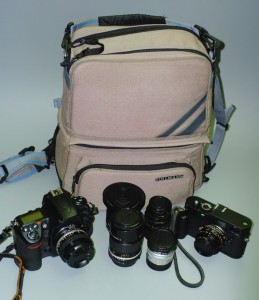
De repente recordé mis ópticas AIS (Auto Indexing Shutter) de Nikon, unos objetivos manuales que apenas abultan y pesan muy poco y eso que son muy luminosos, el 50mm. es f:1.4 y el 135 es f:2.8. Cierto es que en gran angular tengo el Nikkor 24mm pero AF, es decir autofocus y también el Zeiss 25mm. f:2 manual, uno de mis objetivos favoritos ya que es capaz de enfocar a menos de 2 centímetros, si has leído bien dos cm. y capaz de captar unos colores especiales. Sin embargo su peso y tamaño es muy superior al de Nikon pero, … que más da unos gramos más con tal de no transgredir mi ilusión de rememorar mis años jóvenes más cercanos al movimiento hippie. Todos estos cristales funcionan perfectamente en la Nikon D700 que también me llevé, eso sí, sin el grip que tanto me gusta.
También recordé una mochila pequeña que tenía guardada hace años en el trastero. Gran descubrimiento y gran mochila, perfecta para llevar algo de ropa en su parte inferior y la Nikon con las 3 ópticas en la parte superior. Curiosamente me quedaba sitio para la Leica y unas ópticas parecidas a las de Nikon, en concreto un Zeiss 21mm. f:4.5 , un Leica Sumicron 35mm. f:2.0 y el Leica Tele Elmarit 90mm. f:2.8
Antes de meter todo en la mochila y como pensaba moverme en zonas y horas poco conocidas, me acordé que algunos amigos “tunean” sus cámaras para que pasen más desapercibidas a los ojos de amigos de lo ajeno. Creo que es un poco paranoia pero en esta ocasión lo hice por si acaso. Puse cinta de carrocero pintada previamente de color negro para tapar el logo rojo de Leica y la marca Nikon. También cambié la cinta de la Nikon, muy llamativa por cierto y puse la de una Contax antigua que dicho sea de paso siempre me ha gustado mucho por su sistema rápido para quitar y poner.
Suelo viajar mucho a Lisboa pero siempre viajes muy “cerrados” y en esta ocasión el espíritu era disfrutar de la fotografía y sobre todo conocer a la gente de otra manera diferente a lo que suelo hacer. Mi viaje era algo así como de el típico turista sin más.

Leica M8 – Carl Zeiss 21mm. – f:8 – 1/180 – ISO 320
Dicho y hecho, todo en la mochila y para el aeropuerto. Este viaje me podía servir para decidir con que sistema me siento más cómodo e incluso para alternar. Al final de esta entrada daré un veredicto y de mi opinión, pero antes contaré mis experiencias.
Nada más llegar a Lisboa, taxi al hotel donde dejé un par de camisetas y a caminar con mi mochila cargada de joyas manuales. Antes de salir pensé dejar el equipo Leica por aquello que pronto me pillaría la noche y este sistema no es aconsejable utilizarlo con más de 650 ISO por el tema del ruido pero por otro lado pensé que mis cámaras siempre me acompañan si o si.
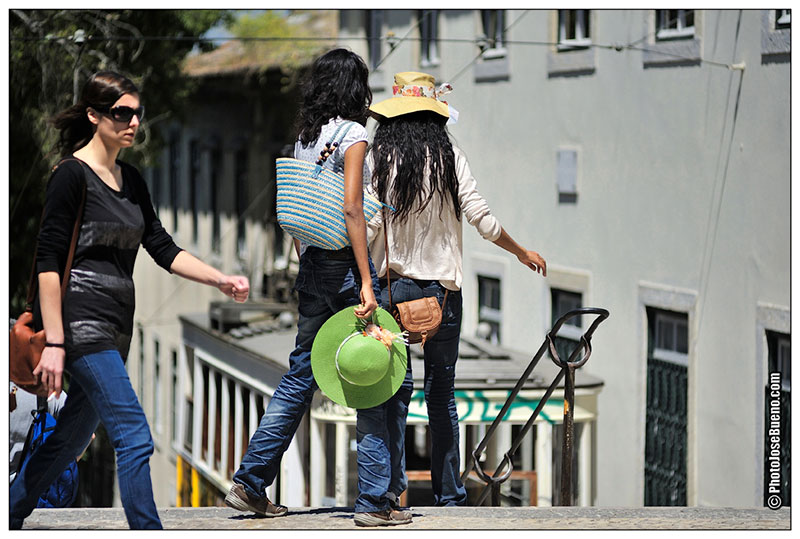
Nikon D700 – Nikkor 135mm. – f:2.8 – 1/8000s – ISO 200
En mi cabeza llevaba las típicas fotos de turista pero también quería ver la gente y su cultura huyendo de las típicas fotos que recogen la mendicidad. De todas formas me sorprendió que ese tipo de fotos son más fáciles de conseguir en mi ciudad, dichosa crisis, parece que nos afecta más que a nuestros vecinos a pesar de lo que se oye en las noticias.
Al bajarme del metro en la parada de Restauradores, lo primero que veo es el famoso funicular que te sube al barrio alto. Es muy chulo pero es para “guiris” ya que cuesta 3,60 euros. Como me pareció tan caro y me apetecía hacer fotos de él, decidí subir la cuesta andando con mi mochila. Creo que acerté pues saqué alguna foto chula y la cuesta no es para tanto, al menos para pagar ese precio salvo que tengas que hacerlo con muletas.
Ya en el Barrio Alto, desde San Pedro de Alcántara hay unas vistas impresionantes que no te puedes perder. Ahí utilicé ambas cámaras con los objetivos gran angular para tener una buena panorámica pero me gustó mucho más la imagen tomada con el teleobjetivo comprimiendo los bonitos tejados de tonos rojizos en perfecta armonía con los ocres de las fachadas de las casas. Es una pena que no había apenas nubes para adornar la imagen.
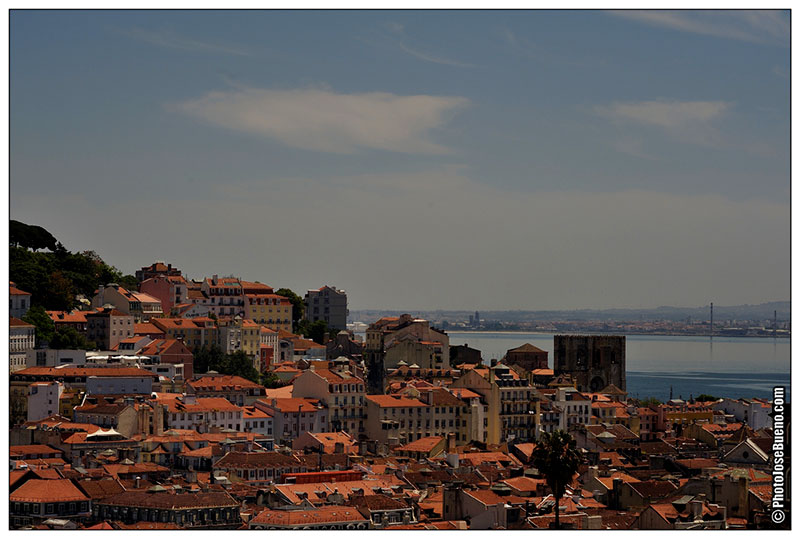
Nikon D700 – Nikkor 135mm. – f:2.8 – 1/8000s – ISO 200
Llegó la noche y decidí cenar en la típica taberna donde se come muy bien y a buen precio, el restaurante Tascardoso, muy amables como todos los portugueses y una cena genial. Con las fuerzas repuestas tocaba visitar Lisboa la “nuit”. En todo momento me sentí muy seguro y me arrepentía de haber tuneado mis cámaras, que tontería.
También cuando decidí ir de viaje, miré el tiempo y vi que no llovería. Esto suelo hacerlo para ver si llevo o no protección fundamentalmente para mis cámaras pero los pronósticos eran de buen tiempo sin lluvias. Por una parte es buena noticia pero frustraba un poco mi idea de hacer esas fotos con reflejos en el suelo siempre tan interesantes. Afortunadamente Lisboa mantiene esas aceras con suelos de pequeños adoquines muy desgastados por las pisadas y que en la noche o media tarde reflejan unos preciosas imágenes casi como si hubiese llovido y sin mojarnos. Si vas hacer fotos recuerda quitar los polarizadores para obtener esos reflejos.
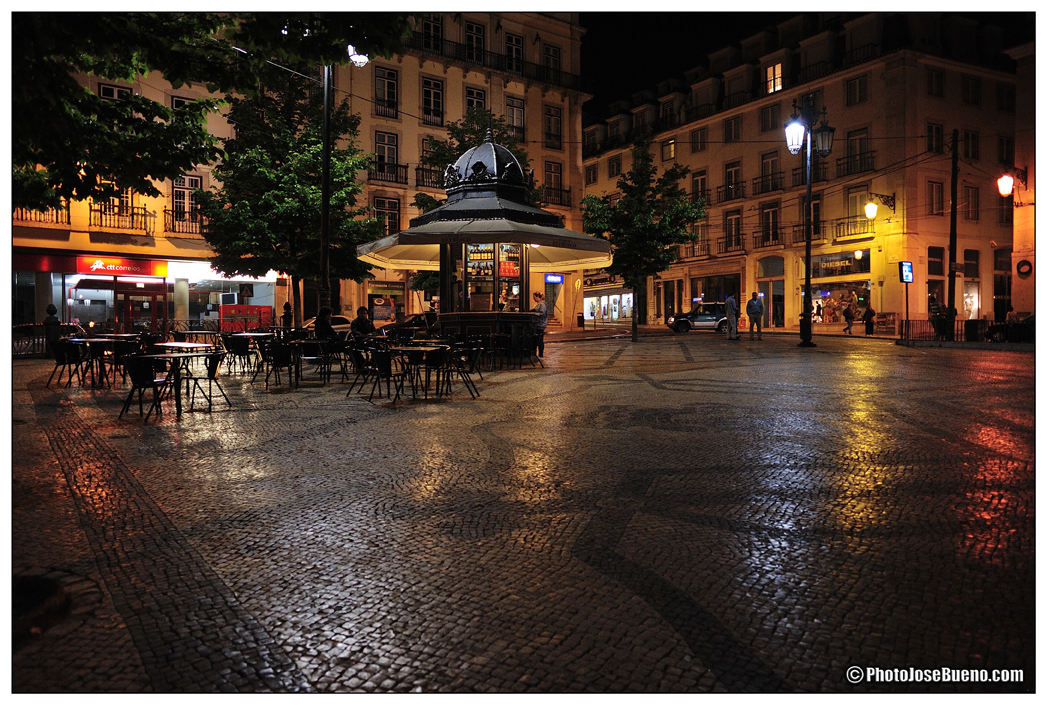
Nikon D700 – Carl Zeiss 25mm. – f:2.8 – 1/40s – ISO 1600
La gente cenando en terrazas, gente paseando por esas angostas calles poco iluminadas, era el lugar perfecto para llenar la memoria de mi tarjeta. Por fin estaba disfrutando a tope con mi actual profesión.
Al día siguiente me fui a Cascais y Estoril, a poco más de media hora en tren. Aquí ya podía utilizar la Leica pues hacía un día que su luz me recordaba mucho a la del mediterráneo. El único problema fue el calor que hacía la mochila un poco más pesada de lo normal aunque estaba contento de haber llevado los dos equipos, especialmente los teles …
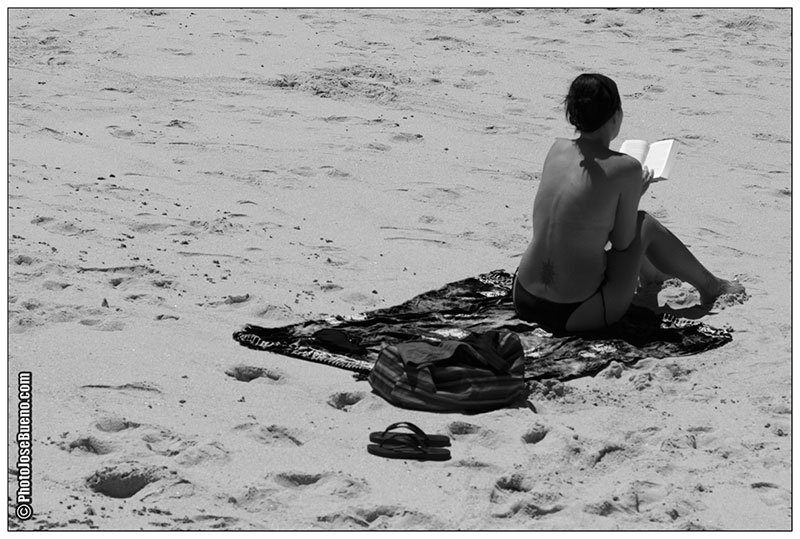
Leica M8 – Leica Tele Elmarit 90mm. – f:6.7 – 1/2000s – ISO 160
A mi vuelta de la breve visita por la costa, hice una parada en Belem desde donde se puede fotografiar el famoso Ponte 25 de Abril, para mí mucho más fotogénico que el moderno Puente Vasco de Gama.
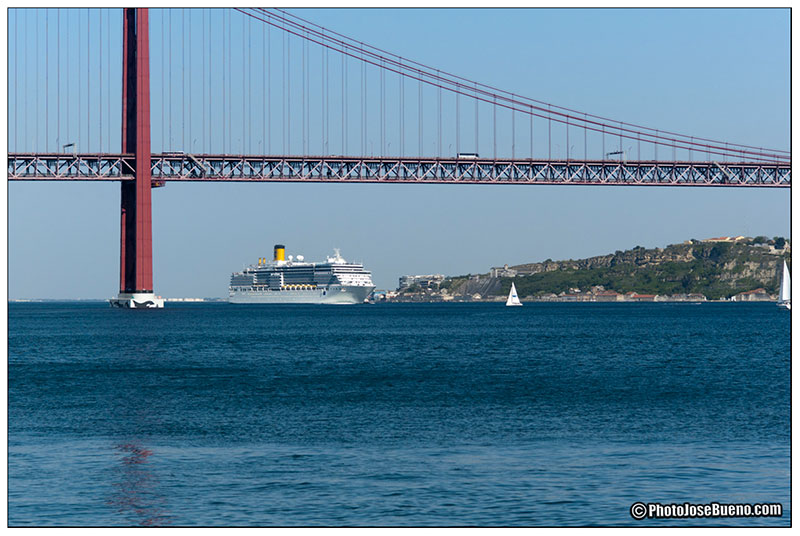
Leica M8 – Tele Elmarit 90mm. – f:5.6 – 1/2000s – ISO 160
En este caso y aprovechando la salida de un transatlántico, aproveché la ocasión para hacer unas imágenes con el teleobjetivo y obtener por comparativa la grandiosidad de tan generoso puente. También quise aprovechar la interesante pose de una joven que se encontraba leyendo un libro y así conseguir una imagen más humanizada.
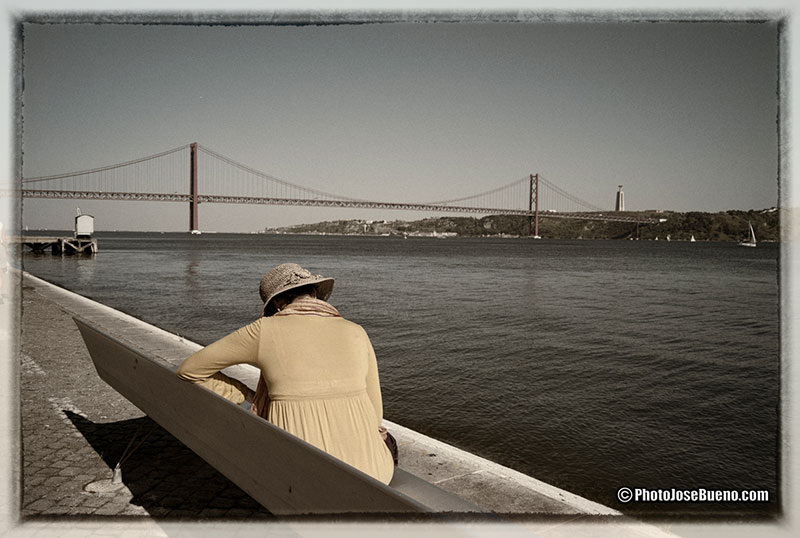
Leica M8 – Leica Summicron 35mm. – f:4.8 – 1/1500s – ISO 160
A mi llegada de nuevo a Lisboa, no podía faltar la típica vuelta en famoso tranvía 28 que te lleva por esas angostas calles. Quitando alguna foto que hice alguno de los ocupantes del tranvía como la de un indio cuya expresión era increíble, preferí disfrutar del paseo y descansar un poco.
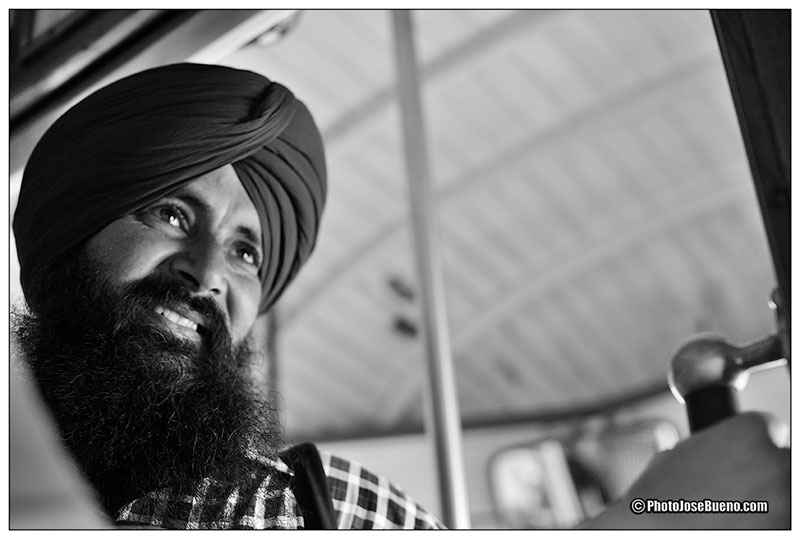
Nikon D700 – Nikkor 50mm.- f:2.8 – 1/160s – ISO 200
El último día aproveché para hacer otra rápida visita a Sintra, una preciosa villa situada en tren a 40 minutos de Lisboa y que la Unesco clasificó como Patrimonio de la Humanidad. Es un lugar perfecto para hacer fotografías desde que te bajas del tren pero apenas dediqué la mañana para visitar toda la grandiosidad que ofrece este paraje tan interesante. Esto por un lado es bueno pues así tengo una buena disculpa para volver con más tiempo a este bello sitio.
El viaje ha sido cansado pero más que interesante. Muy recomendable para todo aquél que quiera disfrutar de la fotografía, la buena comida y el buen rollito que transmiten nuestro vecinos portugueses.
No me he olvidado de comentar con que sistema me encontré más cómodo. Pues bien ha ganado por goleada la réflex y es que quizás es un sistema que domino mucho más que el sistema telemétrico. El enfoque en réflex me resulta tan exacto como el telemétrico pero mucho más rápido.
Creo que con un par de ópticas hubiese sido suficiente, en concreto un gran angular y un tele objetivo, dejando los intermedios como el 50mm. de Nikkor y el 35mm. de Leica que apenas he usado a pesar de su calidad.
Hablando de calidad, bouquet y todas esas cosas que se dicen, ambos sistemas son muy buenos. En fin para gustos los colores, … o, el blanco y negro.
Por cierto he incluido al inicio de esta entrada una imagen muy tópica pero que identifica perfectamente Lisboa y para despedirme incluyo otra con su nombre.
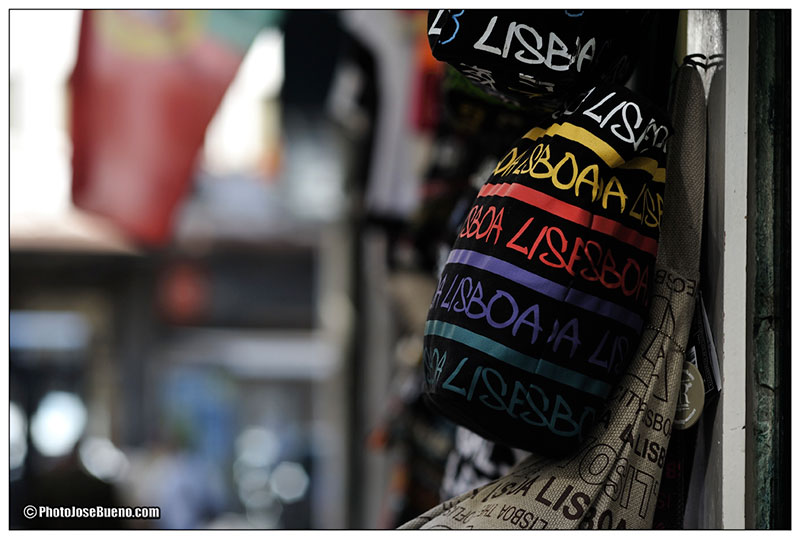
Nikon D700 – Nikkor 135mm. – f:4.0 – 1/500s – ISO 200
Are you coming to Lisbon …?
Wearing long time thinking about a weekend getaway in search of photographs different from what I usually do lying on roads or circuit testing and photographing cars. Not that I do not like but surely you’ll agree that even the most exquisite dish tired.
My idea was to get some of my origins in the world of photography with a manual focus camera, and remembered my first SLR Zenit brand that I bought almost 40 years ago already.
Dismissing the film cameras that I have of collection and work perfectly but your system is me too «romantic» as good Gemini I ended up deciding whether to carry an SLR or rangefinder. On one hand I am much more accustomed to using SLRs but on the other hand, many of my friends talk and talk about the benefits of light weight of the telemetry and quality but to be honest it took me forever to work with this system.
Also please bring lightweight was my bad experience of my recent trip to the Circuit de Catalunya in Barcelona where Peli loaded with full of Nikkor optics, to 300mm. f: 2.8 that just over 3 kilos, in total we had about 15 kilos and up the plane suitcase compartment hurt my lower back and spent a few days annoyed.
I suddenly remembered my optical AIS (Auto Indexing Shutter) lenses, manual targets just bulk and weigh very little and they’re very bright, the 50mm. is f: 1.4 and the 135 is f: 2.8. It is true that at wide angle but I have the Nikkor 24mm AF, ie the Zeiss 25mm autofocus. f: 2 hand, one of my favorite targets since it is able to focus less than 2 inches, if you’ve read either two cm. and able to capture some special colors. However, their weight and size is much higher than Nikon but … who cares about grams so as not to transgress my illusion of remembering my younger years closest to the hippie movement. All these crystals work perfectly on the Nikon D700 also I took, though, without the grip that I like.
I also remembered a small backpack that was saved in the attic for years. Great find and great backpack, perfect for carrying some clothes in the bottom and the 3 Nikon lenses on top. Interestingly I had room for some optical Leica and Nikon similar to, specifically a 21mm Zeiss. f: 4.5, one Sumicron 35mm. and Tele Elmarit 90mm.
Before you put everything in the bag and as I thought and hours move in unfamiliar areas, I remembered that some friends «tunean» cameras to spend more unnoticed by foreign friends. I think it’s a little paranoia but this time I did it just in case. I put masking tape to cover the red Leica logo and brand Nikon. I also changed the Nikon tape, very striking indeed one and put the old Contax incidentally that I always liked it for its fast to get on and off.
Ground travel much travel to Lisbon but always very «closed» and this time the spirit was enjoying photography and especially meet other people differently than I usually do. My trip was something like no more than the typical tourist.
Said and done, everything to the pack and to the airport. This trip could be used to decide which system I feel more comfortable and even to switch. At the end of this entry will give a verdict and my opinion, but first tell you my experiences.
Upon arrival at Lisbon, taxi to the hotel where I left a couple of shirts and walk with my backpack full of jewels manual. Before I leave the computer out for what soon Leica pillaría me night and this system is not advisable to use ISO 650 over the noise issue but otherwise I thought my camera always with me whether or if.
In my head was the typical tourist photos but also wanted to see the people and culture typical fleeing beggary collecting photos. Anyway I was surprised that such pictures are easier to get in my city, happy crisis, it seems that affects us more than our neighbors despite what you hear on the news.
When I got off the subway at the stop Restorers, the first thing I see is the famous funicular that takes you up to the upper quarter. It is very cool but it’s for «touristy» as it costs 3.60 euros. As it seemed so expensive and I wanted to take pictures of it, I decided to walk up the hill with my backpack. I think I was right because I took a nice picture and the cost is not so bad, at least to pay that price unless you have to do it on crutches.
Already in the Barrio Alto, from San Pedro de Alcántara there are stunning views that you can not miss. There used both cameras with wide-angle lenses to get a good view but I enjoyed it more the image taken with the telephoto compressing the beautiful reddish roofs in perfect harmony with ocher facades of the houses. It’s a shame that there was not a cloud to decorate the image.
Night came and I decided to dine at the tavern where you can eat well and cheaply, Tascardoso restaurant, very friendly and all the Portuguese, and a great dinner. With forces played visiting Lisbon answers «nuit». At all times I felt safe and I regretted having tuned my cameras that nonsense.
Also when I decided to go on a trip, I checked the time and saw that it would not rain. This usually do to see if I have or not primarily to protect my cameras but forecasts were a good time without rain. On the one hand is good news but a bit frustrated my idea of making those pictures with reflections on the floor ever so interesting. Fortunately sidewalks Lisbon keeps those small cobblestone floors badly worn by footsteps and in the evening or afternoon reflect some beautiful images almost as if it had rained without getting wet. If you do remember to remove the polarizers photos for those reflections.
People dining on terraces, people walking by these dimly lit narrow streets, was the perfect place to fill my memory card. Finally butt was enjoying with my current profession.
The next day I went to Cascais and Estoril, just over half an hour by train. Here we could use the Leica for it was a day that reminded me so much its light to the Mediterranean. The only problem was the heat that made the pack a little heavier than normal but was glad I brought the two teams.
On my return from a brief visit to the coast, I made a stop in Belem where you can photograph the famous Ponte April 25, for me much more photogenic than modern Vasco da Gama Bridge.
In this case and using the output of a liner, took the opportunity to take some pictures with a telephoto lens and get by comparing the grandeur of so generous bridge. I also wanted to take advantage of the interesting pose of a young man who was reading a book and thus get a more humanized.
Upon my arrival back to Lisbon, could not miss the typical back in famous tram 28 takes you through these narrow streets. Removing any pictures that I did any of the occupants of the tram as an Indian whose expression was amazing, I preferred to enjoy the ride and get some rest.
The last day took the opportunity to do another quick visit to Sintra, a beautiful villa located 40 minutes by train to Lisbon and classified by Unesco as a World Heritage Site. It is a perfect place to take pictures since I get off the train but just spent the morning to visit all the grandeur offered by this place so interesting. This on one hand is good as well I have a good excuse to return with more time to this beautiful site.
The trip was tiring but very interesting. Highly recommended for anyone who wants to enjoy photography, good food and good vibes that convey our Portuguese neighbors.
No I forgot to comment that I found most comfortable system. Well has won by a landslide the SLR and that perhaps is a system that dominated much more than the telemetric system. The SLR approach I find as accurate as the telemetry but much faster.
I think with a couple of lenses would have been sufficient, in particular a wide angle and a tele lens, leaving the middle as the 50mm. Nikkor and 35mm. Leica that I have barely used despite its quality.
Regarding the quality, bouquet and all those things said, both systems are very good. In order to taste the colors, …, or black and white.
By the way I have included at the beginning of this entry a quite topical but perfectly identifies goodbye Lisbon and another with your name included.